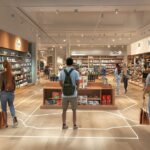In today’s competitive entertainment landscape, amusement parks are continually seeking innovative ways to enhance guest experiences, boost customer engagement, and streamline park operations.
One powerful tool gaining traction is location analytics, which uses data to provide insights into visitor behavior, foot traffic analysis, and park dynamics.
This article explores the benefits of location analytics, from enhancing guest experience, increasing customer satisfaction, and optimizing operational efficiency to driving revenue growth through data-driven decisions.
We will break down how this technology works, how to implement it effectively, and share case studies of parks that have successfully adopted these strategies.
Join us as we uncover the potential of location analytics in the amusement park industry, including its applications in smart parks and business intelligence.
Definition and Overview

Location analytics involves the collection and analysis of geospatial data to gain actionable insights into visitors’ habits, travel patterns, and preferences in various environments, such as amusement parks.
By utilizing geolocation technologies like GPS tracking and heat mapping, location analytics enhances the guest experience, improves operational efficiency, and tailors offerings to align with the specific preferences and needs of visitors.
The integration of real-time tracking and predictive analytics allows park operators to visualize data trends, aiding in customer journey mapping and experience design. This capability enables parks to identify peak visitor traffic times, trending ride preferences, and to deploy staff more proactively in areas with heavy foot traffic.
Additionally, location analytics fosters improved user engagement by facilitating personalized experiences for visitors, such as targeted marketing campaigns, real-time notifications about ride wait times, and interactive maps for on-site navigation.
The overall impact of these strategies not only leads to valuable operational insights, metrics, and enhanced safety monitoring but also boosts visitor satisfaction, ultimately driving loyalty and encouraging repeat visits through loyalty programs.
Benefits of Using Location Analytics in Amusement Parks
Integrating location analytics into amusement parks offers numerous benefits that significantly enhance the guest experience, improve operational efficiency, optimize revenue, and provide marketing insights for better business growth.
By utilizing advanced data analysis tools and geospatial information, parks can effectively monitor visitor flow, manage queues, and assess the popularity of attractions. This data-driven approach enables personalized guest experiences through mobile applications and targeted marketing strategies, ultimately resulting in higher customer satisfaction and stronger loyalty programs.
Furthermore, the capability to leverage real-time insights into visitor demographics, demographic trends, and attendance patterns supports strategic event planning and effective management of seasonal trends.
Improved Guest Experience
The enhanced guest experience in amusement parks, largely driven by location analytics, stems from the personalization enabled by user profiles and preferences. By analyzing data from mobile applications and interactive maps, parks can make tailored recommendations for attractions and amenities, resulting in greater engagement and satisfaction.
Real-time tracking of visitor behavior allows parks to adjust their offerings dynamically, creating a more individualized experience that aligns with guest expectations, enhances overall enjoyment, and boosts customer engagement.
For instance, mobile app integration can send visitors push notifications about nearby attractions based on their specified interests, such as thrill rides for adrenaline seekers or family-friendly experiences for parents with young children, leveraging geolocation and location-based services.
Additionally, interactive experiences like augmented reality can assist guests in navigating the park while providing insights into its history or fun facts related to their current location. These technologies foster connection and engagement, enabling parks to curate memorable experiences that ensure each moment spent is cherished by visitors.
Efficient Operations

Operational efficiency at amusement parks can be enhanced through location analytics, which facilitate efficient queue management, capacity planning, and staffing optimization.
By gaining real-time location insights into visitor flow and traffic patterns, park management can allocate staff more effectively. This leads to reduced wait times and improved operational workflows.
Increased Revenue
Amusement parks can increase revenue by leveraging location analytics to develop effective marketing strategies and targeted advertising. By analyzing visitor behavior and customer journeys through data, parks can create personalized promotions and enhance user engagement through loyalty programs and digital signage.
This targeted approach not only boosts attendance but also increases the average spending per visitor, ultimately driving revenue optimization through cross-analytics and experiential marketing.
Utilizing location-based insights allows amusement parks to refine their marketing campaigns by identifying peak visitation times, popular attractions, and demographic trends among guests. This intelligence enables the design of tailored experiences that resonate with visitors’ preferences, leading to higher engagement metrics.
For instance, strategic messaging delivered through mobile applications at opportune moments can encourage greater participation in special events, exclusive deals, or virtual queueing, ensuring that marketing efforts are not just heard but actively acted upon.
By fostering a deeper connection with their audience through social media integration and feedback loops, amusement parks can capitalize on these trends, cultivating customer loyalty that translates into repeat visits and long-term profitability.
How Location Analytics Works in Amusement Parks
Location analytics in amusement parks employs various data collection methods, including real-time visitor flow tracking and heat maps that illustrate foot traffic patterns.
By utilizing technologies such as GPS and mobile applications, amusement parks can gather geospatial data, which is then analyzed to predict visitor behavior and optimize service delivery.
Merging real-time insights with spatial analytics enhances decision-making, resulting in improved operational efficiency, data visualization, and a better overall guest experience.
Collection of Data

The collection of geospatial data in amusement parks is a crucial aspect of location analytics, allowing parks to conduct thorough analyses of foot traffic, visitor demographics, and understand visitor interactions.
By utilizing various survey tools and mobile applications, parks can gather direct feedback from guests, which complements passive data collection methods such as GPS tracking and location tracking to enhance insights into user behaviors and preferences.
Additionally, operators frequently analyze guest movement patterns to identify popular attractions and peak times. This analysis not only helps in managing crowds effectively but also enhances user engagement by facilitating tailored experiences.
By integrating real-time data collection approaches, amusement parks can refine their operations, enhance safety with social distancing measures, and ensure that each visitor has a memorable day.
User interactions captured through surveys and digital platforms provide valuable insights into satisfaction levels and areas for improvement. By emphasizing these diverse data collection methods, parks are increasingly equipped to create optimal experiences that resonate with their guests.
Data Analysis and Visualization
Data analysis and visualization are essential for transforming raw geospatial data into valuable insights for amusement parks. Tools like heat maps and performance metrics help interpret visitor behavior effectively.
By utilizing advanced data visualization tools, amusement park operators can identify trends, assess engagement metrics, and adjust operational strategies to enhance the overall guest experience. These insights enable both short-term and real-time adjustments to attractions and services, allowing management to make data-driven decisions for future expansions and marketing campaigns.
Using advanced analytics platforms, operators can leverage tools such as Geographic Information Systems (GIS), predictive analytics, and smart technology to visualize customer flows and peak times, facilitating better staffing and resource allocation.
Heat maps are particularly effective for visualizing high-traffic areas, which are crucial for understanding visitor preferences, optimizing park layout, and enhancing layout designs for improved guest flow.
Performance metrics provide important quantitative measures that assist park operators in improving their effectiveness. These metrics quantify an organization’s actions and outcomes in terms of inputs, outputs, and results. They help operators benchmark their park attractions, rides, and services against those of other parks and the industry as a whole.
By analyzing these performance metrics, amusement park operators can identify the strengths and weaknesses of their attractions, ultimately leading to improved visitor experiences and enhanced user experience through gamification and immersive experiences.
Implementing Location Analytics in Amusement Parks
Implementing location analytics in amusement parks requires careful consideration of technology selection, mobile engagement, and staff training to ensure effective usage that leads to process improvements, enhanced safety, and data-driven decision-making.
Parks must choose the right technologies tailored to their specific operational needs, enabling mobile engagement, real-time analytics, and location intelligence capabilities that enhance both guest services and operational workflows.
Choosing the Right Technology

Choosing the right technology for location analytics is essential for amusement parks to gain valuable insights into their operations and to engage visitors through mobile applications and GPS technology.
Parks should evaluate the available tools and solutions to determine which ones best work together with their existing systems, focusing on those that offer comprehensive data tracking, data visualization, and reporting for improved operational efficiency and guest experience.
This evaluation should consider not only the user interface and ease of use for staff but also the technology’s capacity to efficiently handle large volumes of data. Promising systems should be compatible with current ticketing, scheduling, and event attendance solutions, thereby enhancing the overall customer experience and operational insights.
Furthermore, assessing the ability of these solutions to provide real-time analytics and location intelligence can significantly aid in well-considered choices and park operations optimization.
By utilizing location-based technology and user behavior tracking, parks can adjust their operations to better meet guest expectations, ultimately improving foot traffic analysis, attendance, and visitor satisfaction.
Training and Implementation
Staff training and a clear implementation strategy are essential for the successful adoption of location analytics in amusement parks, as they enable staff to effectively utilize the data generated to enhance user engagement, customer insights, and improve operational processes.
To fully realize the benefits of location analytics, parks must develop comprehensive training programs that include hands-on training, feedback loops, and familiarization with analytics tools and mobile technology integration.
For the training to be effective, it is crucial to establish clear learning outcomes that align with the park’s operational goals and marketing strategies. A combination of theoretical knowledge and practical training can enable staff to comprehend the significance of data interpretation, social media integration, and well-considered choices.
Additionally, mentorship and regular workshops can serve as valuable resources for employees to provide feedback and suggestions regarding the analytics processes. This approach fosters a culture of continuous improvement, allowing employee feedback to enhance the use of location analytics and operational efficiency.
Incorporating technology to offer remote learning modules can further improve access to training and ensure that all employees are informed about the latest best practices, innovative technologies, and smart parks innovations in the field.
Case Studies of Successful Implementation
Case studies highlighting the successful application of location analytics in amusement parks illustrate how data analytics can enhance visitor experiences, guest journey mapping, and improve operational efficiencies.
By gathering insights from visitors across multiple parks and utilizing business intelligence tools, these analytics help optimize user experience and interactions, tailor offerings, and align with guest preferences through demographic analysis and guest profiling.
As a result, parks have achieved higher customer satisfaction, visitor retention, and loyalty programs success rates.
Examples of Amusement Parks Using Location Analytics
Here are some examples of amusement parks that have successfully implemented location analytics, showcasing how this technology can enhance guest services and drive operational improvements. Amusement parks employing data-driven decisions and strategies can improve queue management, optimize visitor flow, and personalize guest experiences through tailored engagement initiatives, supported by interactive maps and mobile app integration.
For instance:
- Disneyland has integrated location services and geolocation to assess crowd density and movement, enabling them to adjust staffing levels and open additional ride entry points during peak times, thereby enhancing crowd management and park layout optimization.
- Six Flags utilizes GPS technology to track guest movements and visitor behavior, which allows them to develop custom marketing campaigns, targeted promotions, and guide guests toward attractions and amenities they are likely to enjoy.
These parks not only enhance existing operational processes, such as faster ride dispatching and ride popularity analysis, but also anticipate visitor needs with greater accuracy through sentiment analysis and guest feedback. This proactive approach leads to increased guest satisfaction, encourages repeat visits, and supports park investment and growth.





